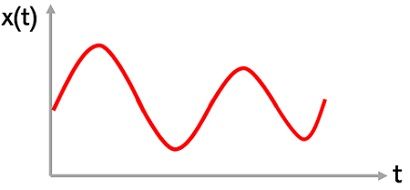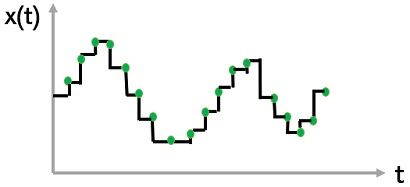The two major categories in which a signal is classified is analog and digital. The crucial difference between Analog and Digital Signal is that an analog signal is a continuous signal which is defined for every particular instant of time. On the contrary, a digital signal is of non-continuous nature, defined discretely at some specific time instants.
Due to the different nature of the two signals, these find applications in different fields.
What is Signal?
In electronics and field of signal processing, a signal is defined as an electric current or energy that carries information. A quantity that varies in space and time is utilized as a signal in order to transmit the data from one point to another. So, basically, the type of information carried out by the signal leads to its classification as analog and digital.
Content: Analog Vs Digital Signal
Comparison Chart
Definition of Analog Signal
Analog signal is continuous in nature as it is well defined for every specific time. More specifically, it is the one defined continuously for a range of values with time. These are represented as a sinusoidal waveform. The figure below represents an analog signal:
As we can see here that the signal is continuous in nature as its every value is specified for each particular interval of time, thus, is referred as the continuous-time signal. For the purpose of recording the analog signals, the actual signal must be preserved as only in that case we can record the accurate analog signal.
However, whenever in any application there arises a need to change an analog signal into a digital one then through sampling this can be achieved. In the sampling technique, this signal is sampled at certain fixed time intervals and the sampled voltage is converted into digital values.
Definition of Digital Signal
A type of signal which is non-continuous in nature as it is defined only for a set of discrete times is known as a digital signal. More simply, we can say, it is specified at some particular time instants only. Thus, here the information is represented as a set of discrete values. The figure given below shows the signal representation in digital form:
Here it is clear that the data is discretely positioned in time axis thus is shown in the form of bits i.e., 0 and 1. This means that here the signal performs the sudden transition between 0 and 1 where these two values correspond to the two voltage levels. For the purpose of recording the signals, in the digital one, only the samples of the actual signal are taken and not the whole signal.
Key Differences Between Analog and Digital Signal
- Analog and digital signals are differentiated mainly on the basis of their way to carry the information. Analog signals represent the information as a continuous function of time. As against, digital signals are represented discretely at specific time intervals.
- Analog signals deteriorate more easily than digital one as their susceptibility towards noise is higher.
- The devices that operate on an analog signal need more power for transmission and reception than the devices that work on the digital signal.
- The information represented by the analog signal is comparatively more accurate than the digital signal due to its continuous range of values.
- Analog signals are transmitted at a slower rate than digital signals as the information holds more values thus is precise.
- An analog signal is defined by the amplitude, phase, frequency, etc. While the digital signal is mainly associated with bit rate, bit intervals, etc.
- The sinusoidal representation of the analog signal makes it difficult to understand or get decoded thus encryption is not required in analog signals. But as the digital signals are in the form of square waves, thus, it can be decoded easily hence need to be encrypted for secured communication.
- On the basis of processing, it is said that the continuous nature of the signal offers easy processing of the analog signal. However, the discrete nature of the signal offers difficultly in the processing of the digital signal.
Conclusion
Thus, the above discussion concludes that due to the way of representing the signal, the two are differentiated. And because of this, the two types of signals possess different properties and are used in different applications. Like analog signals are used in radio wave transmission and reception whereas digital signals are used in the field of digital electronics.


